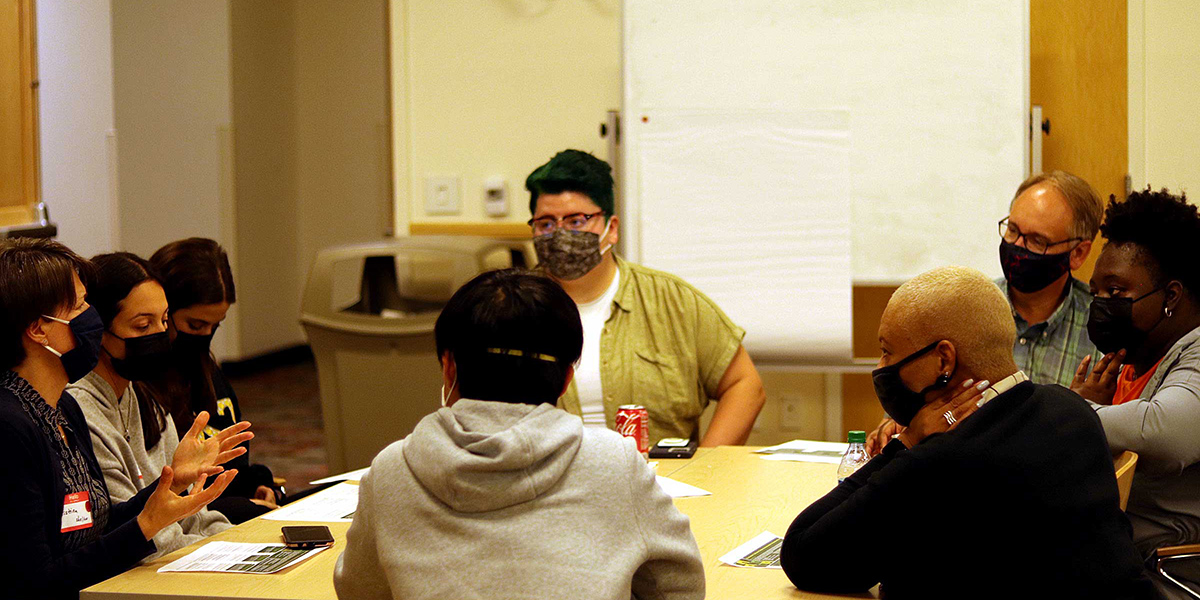Binghamton University holds deliberative dialogue on inclusion and the First Amendment

As the population of the United States becomes more diverse and political polarization intensifies at unprecedented rates, colleges and universities across the country find themselves struggling to strike a balance between protecting free speech and maintaining a safe and inclusive atmosphere for all students. At Binghamton University, a coalition of campus entities including students, faculty and staff has been meeting since the spring of 2019 to find ways to allow for productive campus-wide conversations on these topics, culminating in a deliberative dialogue on the First Amendment and inclusion that took place Monday, Sept. 27.
The group had hosted two virtual roundtable debates in October 2020 and March 2021, which focused broadly on free speech and safety on campus and gave select students from across the political and ideological spectrum equal time to share their perspectives with participants in a civil, mediated forum. The deliberative dialogue, which was supposed to take place last spring but was postponed due to COVID-19, was meant to involve more of the campus community in these conversations.
“Deliberative dialogues provide space to unpack really complex societal issues and identify solutions,” said Lea Webb, a diversity specialist in the Division of Diversity, Equity and Inclusion and a chief organizer of the event. This method of addressing challenges within a community focuses on individuals sharing personal experiences and then considering the pros and cons of various ways the issue might be addressed. The goal is to fully explore different options and determine if there are full or partial solutions that might be agreed upon by community members.
At Whose Freedom? A Deliberative Dialogue on Inclusion and the First Amendment, small groups of six to 10 students, faculty and staff considered three “frames” or possible approaches to advancing inclusion and First Amendment rights on campus, discussing the advantages and tradeoffs of each approach for 20 minutes.
“With deliberation, it’s facilitated and guided,” said Tanyah Barnes, associate director of operations for the Division of Diversity, Equity and Inclusion and a member of the planning committee. “You’re taking an issue and you’re putting it into frames to intentionally review it. As you’re dialoguing, you remove some of the power differential in the conversation but still have people who come with different personal experiences and different professional experience levels who can all share their unique perspectives on a complex topic.”
The frames used were adapted from the National Issues Forum’s Free Speech & The Inclusive Campus issue guide. The first frame explored the question of whether or not the First Amendment and an inclusive campus are in direct opposition to each other. Participants considered this from the perspective of prioritizing student safety and well-being above all else. Part of the deliberative dialogue framework includes considering external contexts specific to a community’s circumstances, such as Binghamton University’s status as a public institution, legally bound to extend full First Amendment rights to all students. Participants had to consider ways of ensuring student well-being while not infringing on anyone’s constitutional rights.
The second frame asked participants to balance the rights of individuals with the responsibilities of the institution, from the stance that the University should welcome the rights guaranteed by the First Amendment, even when it leads to the spread of controversial ideas. Finally, participants discussed ways to create a campus culture that affirms the educational value of curiosity and engaging with different perspectives while guiding students through the uncomfortable feelings and experiences that are bound to arise.
Participant feedback was generally positive, with many individuals expressing an appreciation for the opportunity to have these difficult discussions in a productive manner.
“I think [the deliberative dialogue format] worked well,” said Alicia Mayo, a junior majoring in sociology. “It allowed space for people of different opinions to actually talk with each other and didn’t create this tension of ‘I need to prove that I’m right,’ while at the same time allowing you to give reasons as to why you feel certain ways, or why the way you think can possibly lead to change.”
Following the conversations, groups reported out solutions they had developed for each of the frames. Common themes included offering more formal spaces for open dialogue, such as this event provided; having more proactive, clear and concise communications from the University that define where the institution stands, what constraints they are bound by and what resources are available to students; and providing more education and training to students, faculty and staff in matters of the First Amendment and inclusion on campus.
Mayo and Webb were both optimistic that some solutions were presented that could be implemented relatively soon.
“I liked how we talked about needing to bring awareness both to the definitions [of key terms and ideas] and the resources that provide those definitions,” said Mayo. Webb suggested that integrating these types of discussions and education on these issues into existing general education or First Year Experience courses might be a first step.
“It was really great to have members of the administration in the audience hearing firsthand what folks were experiencing, but also sharing their thoughts and perspectives,” she said.
The planning committee will continue to meet this semester to formulate a report supported by additional research and data.
“One of the great things about deliberation is that you actually can develop an action plan,” said Webb. “Our hope is to have everything pulled together and ready to be shared by the spring. It will definitely be shared publicly, with the campus and, of course, with the respective decision makers.”
Students, faculty or staff members who are interested in getting involved in this work are welcome to join the planning committee, which currently includes representatives from the UDiversity Educational Institute, Multicultural Resource Center, Speech and Debate, Center for Civic Engagement, Scholars Program, Philosophy Department Critical Thinking Lab, Department of Asian and Asian American Studies, Student Association and Graduate Student Organization. Individuals can express interest by emailing deiudiv@binghamton.edu.

